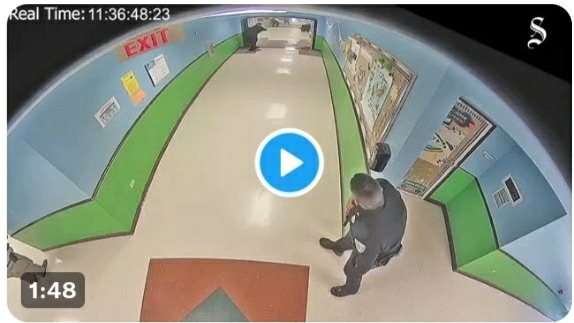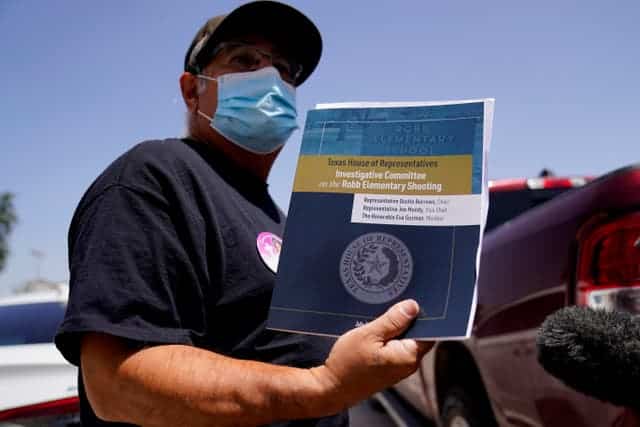Nearly 400 officers were at the scene of the Robb Elementary mass shooting and were unable to apprehend the gunman for 77 minutes.
A Texas House committee criticized law enforcement’s “indifferent approach” to the Uvalde mass shooting after nearly 400 officers stood by for 77 minutes as the shooter killed 19 innocent students and two teachers.
In a damning 77-page report released Sunday, the law enforcement response was described as “chaos” where there was no clear leadership and officers on scene “failed to prioritize saving the lives of innocent victims over their own security”.

“There was a general nonchalant approach by law enforcement at the scene. For many, that was because they received and relied on inaccurate information. For others, they had enough information to know better,” the report states.
The committee, which was tasked with investigating what happened that day, said “systemic failures and egregiously bad decision-making” had hampered the response to the May 24 mass shooting.
He cited multiple failures by nearly every authority involved, including, in addition to the general law enforcement response, the Uvalde school system, the shooter’s family, and social media platforms.
The report also says gunman Salvador Ramos is believed never to have fired a gun before the May 24 massacre, when he fired around 142 rounds in a deadly rampage that left 21 dead.
Victims’ families, survivors and state lawmakers have demanded answers for the past six weeks about what went wrong at Robb Elementary School that day.
Questions have focused particularly on the response by law enforcement after it was revealed that officers waited 77 minutes from the time Ramos entered the school and began shooting until an elite Border Patrol unit led him away. shot dead.
In its scathing conclusion, the committee report said it is “plausible” that this delay cost the lives of some of the victims who were bleeding to death and trapped inside the room with the gunman.
“Given the known information about victims who survived during the time of the breach and who later died on the way to hospital, it is plausible that some victims might have survived had they not had to wait an additional 73 minutes to be rescued,” the report says. fixed.
The Texas House of Representatives committee was charged with investigating both the mass shooting and the multi-entity response. The panel interviewed more than 40 witnesses and law enforcement officers who were at the scene.
The long-awaited report of their findings was first shared with relatives of the victims on Sunday morning before being released to the public.
After giving them time to review the report, the House committee met with the families Sunday afternoon to discuss their findings. At the meeting, they were also shown the 77-minute surveillance video of the hallway inside the school.
The Austin American-Statesman obtained the footage this week and released it before showing it to families. In it, the officers are seen retreating from the gunfire and huddled in the hallway outside the classroom as the massacre continues inside.
Vincent Salazar, the grandfather of one of the victims killed in the massacre, called the police response “a joke” when he picked up a copy of the report on Sunday.
“It’s a joke. They’re a joke. They don’t have to wear a badge. None of them do,” he said. His 11-year-old granddaughter, Layla Salazer, was killed by the gunman.
The three committee members of the Texas House of Representatives, Rep. Dustin Burrows, Rep. Joe Moody and former state Supreme Court Justice Eva Guzmán, said that “the victims, their families and the entire Uvalde community have already waited too long for answers and transparency.”
While much of the blame for the police response was placed on local law enforcement, particularly Uvalde School Police Chief Pete Arredondo, the committee’s report found that state and federal law enforcement also shared blame for the failed response.
Chief Arredondo’s six-member police team was vastly outnumbered by personnel from other agencies and other officers could, and should, have stepped up and taken over as incident commander when it was clear he was not prepared to the task, according to the report.
A staggering 376 law enforcement officers descended on Robb Elementary School to respond to what became the worst mass shooting in Texas history.
They included 149 U.S. Border Patrol, 91 state troopers, 25 Uvalde police, 16 sheriff’s deputies and five Uvalde school police.

The remainder were officers from the Federal Drug Enforcement Agency, US Marshals and police officers who responded from neighboring counties.
“These local officials were not the only ones expected to provide the necessary leadership during this tragedy,” the report states.
“Hundreds of first responders from numerous law enforcement agencies, many of whom were better trained and better equipped than school district police, quickly arrived on the scene.”
These other officers “could have helped address the unfolding chaos,” but “none of the responders took the initiative to establish an incident command post,” the report states.
Despite the conviction of nearly 400 officers at the scene, Chief Arredondo is the only law enforcement officer known to be on leave for the shooting.
Based on the interviews, the committee concluded that active fire protocol requiring officers to confront shooters was ignored and that many officers did not know who was in charge.
However, the report disputed Chief Arredondo’s claims that he did not know he was the incident commander.
The chief had co-authored the school district’s active shooter response plan that states he would be in control in such a situation.
In addition to the law enforcement response, the report also criticized school security protocol, with doors repeatedly being opened and unlocked, and emergency alerts not being taken seriously.
That day, the open doors allowed the gunman to enter the school building with ease.
“If the school staff had closed the doors as required by school policy, that could have delayed [Ramos’] progress for a few precious minutes, long enough to receive alerts, hide the children and close the doors. ”, found the report.
The report also found that some staff did not take the trespasser alert seriously because there have been 47 lockdown events since February, 90 percent of which involved close police pursuits related to immigration and not related to school violence.
The alert system itself was also criticized without the closure being communicated through the school’s intercom system.
Instead, alerts were sent via a smartphone app that the report said some teachers probably didn’t receive because they didn’t have their phones at the time.
The committee also said there were multiple warning signs that Ramos would carry out mass violence, but his behavior was never reported to authorities.
In the months leading up to the attack, Ramos earned the nickname “school shooter” on social media, dabbled in violent sex and was fired from two jobs, including one for harassing a co-worker, the report said.
While still 17, Ramos bought a treasure trove of ammunition after family members refused to buy him a gun.
As soon as he turned 18 on May 16, he began shopping for firearms, and his uncle took him twice to the gun store to pick them up.
It was only eight days after his birthday that he carried out the attack.
The committee also detailed the gunman’s “unstable home life,” including “relative poverty,” his mother’s struggles with addiction issues, and the claim that he may have been abused by his mother’s girlfriend when he was young.
In the week between his 18th birthday and the massacre, the report said Ramos told his family members that he was having suicidal thoughts.
That same week, other family members learned that he had bought weapons. His family told him to get rid of the weapons, but he did not report it to the authorities.
After the massacre, officials undermined public confidence in the investigations by giving a “false narrative” about what happened, according to the report.
Multiple statements made in the days after May 24 were later shown to be incorrect.
On May 25, Texas Governor Greg Abbott said at a news conference that Ramos was confronted by a school resource officer before entering the school and that the shooting was over within 40 minutes thanks to “officers who quickly devised a plan, they stacked up and neutralized the shooting.” aggressor”.
The next day, a DPS official said a teacher had left a school door open, allowing Ramos to enter the building.
Both statements were later found to be false and misled the public about what really happened, according to the report.
The committee also disputed a claim made last week that an armed Uvalde police officer missed an opportunity to shoot the gunman before he entered the building. Instead, the investigation found that it was a coach that the officer had seen, not Ramos.
The committee criticized state officials for misleading the public.
“One would expect law enforcement during a briefing to be very careful in indicating which facts are verifiable and which are not,” the report says.
The damning report is just one of several investigations into the mass shooting, including by the Justice Department.
